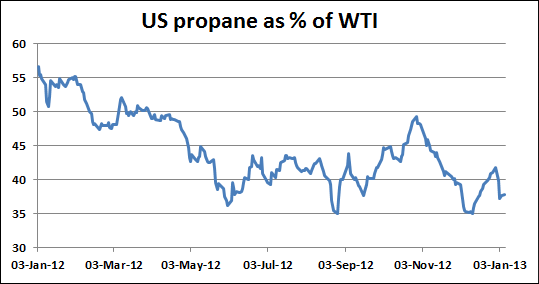The continuing new paradigm in the relationship among various streams of US crudes, and between crude and natural gas, is logically pulling in its next rearrangement: propane.
As Platts Anastasia Gnezditskaia reported recently, the spread between natural gas and propane has narrowed to its lowest level in two years. She quotes a report by analyst Steve Smith, who noted: ď(A) near-record mild 2011-2012 winter and the sharp increase in NGL-targeted drilling has led to very high propane storage levels and more than a 50% contraction in the NGL-to-Henry Hub price ratio,Ē Smith said. ďThe highest ratio was at $9.50/MMBtu on June 2012, while now it is around $2.50/MMBtu.Ē
So that means that propane is moving toward the price of natural gas. But the other relationship thatís shifting at the same time is that of propane to crude oil in the US, with crude moving well above that of the liquid.
Converting propaneís cents per gallon prices to barrels, and comparing that to the price of WTI, shows that the spread between the two started 2012 at a $44.65/b spread in favor of WTI. Through the prices of a few days ago, that spread had blown out to $58, and hasnít been less than $50 since mid-November.
Outright spreads donít always tell the whole story of a changed relationship, because an overall rise or fall in absolute prices can make spreads look narrower or wider even as the percentage relationship between the two doesnít change much. But thatís not the case between propane and WTI. It opened 2012 with non-LTS propane at Mt. Belvieu at roughly 56.6% of the price of WTI. By the end of the year, it was about 37% of WTI, and had been as low as 35%.
This isnít really a surprise. US NGL production is surging on the backs of the shale gas boom, and it isnít likely to taper off. Platts reporting noted that FBR Capital Markets has projected US liquids output growing 9.7% to 2.776 million b/d in 2013, and then tacking on close to 10% the year after, and 8.7% in 2013. The jump in 2012 was 12.9% to 2.530 million b/d.
The problem, as always, remains takeaway capacity, which inhibits the normal forces to economics from readjusting supply. Exporting propane will rise; our friend Rusty Braziel had a good summary of the various projects on the drawing boards that will make that happen.
As we noted in a recent blog, exports of NGLs surged to a record high in October, the last full month for which data is available. And all you need to do is look at the spread between European propane and US propane to see why.

Converting the Platts CIF NWE propane assessment to cents per gallon, it shows that at the start of 2012, the gap between European propane and Mt Belvieu non-LST propane was 25 cts per gallon. It got as wide as about $1.25/gal at the beginning of December, before retreating to 80 cts recently. Even with the contraction of the past weeks, thatís still a large incentive to move propane off the US shores and into Europe or other markets. (If you donít like dealing with numbers, all you need to know is that European propane is at or slightly more than the price of Brent; US propane is significantly less than price of WTI, which in turn is now running about $20/b less than the price of dated Brent.)
Based on recent data, the export rise has begun. And given the ongoing infrastructure construction, itís only going to grow.
© 2012 Platts, The McGraw-Hill Companies Inc. All rights reserved. To subscribe or visit go to: http://www.platts.com